
Sarnath is a place located 10 kilometres north-east of Varanasi near the confluence of the Ganges and the Varuna rivers in Uttar Pradesh, India. The Deer Park in Sarnath is where Gautama Buddha first taught the Dharma, and where the Buddhist Sangha came into existence through the enlightenment of Kondanna.
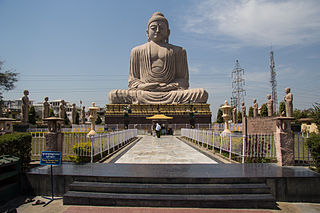
Bodh Gaya is a religious site and place of pilgrimage associated with the Mahabodhi Temple Complex in Gaya district in the Indian state of Bihar. It is famous as it is the place where Gautama Buddha is said to have attained Enlightenment under what became known as the Bodhi Tree. Since antiquity, Bodh Gaya has remained the object of pilgrimage and veneration both for Hindus and Buddhists. In particular, archaeological finds including sculptures show that the site was in use by Buddhists since the Mauryan period.

The pillars of Ashoka are a series of monolithic columns dispersed throughout the Indian subcontinent, erected or at least inscribed with edicts by the Mauryan Emperor Ashoka during his reign from c. 268 to 232 BCE. Ashoka used the expression Dhaṃma thaṃbhā, i.e. "pillars of the Dharma" to describe his own pillars. These pillars constitute important monuments of the architecture of India, most of them exhibiting the characteristic Mauryan polish. Of the pillars erected by Ashoka, twenty still survive including those with inscriptions of his edicts. Only a few with animal capitals survive of which seven complete specimens are known. Two pillars were relocated by Firuz Shah Tughlaq to Delhi. Several pillars were relocated later by Mughal Empire rulers, the animal capitals being removed. Averaging between 12 and 15 m in height, and weighing up to 50 tons each, the pillars were dragged, sometimes hundreds of miles, to where they were erected.
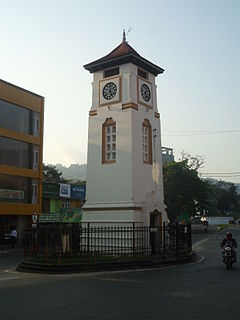
Badulla is the capital and the largest city of Uva Province situated in the lower central hills of Sri Lanka. It is the capital city of Uva Province and the Badulla District.
"The Doom That Came to Sarnath" (1920) is a fantasy short story by American writer H. P. Lovecraft. It is written in a mythic/fantasy style and is associated with his Dream Cycle. It was first published in The Scot, a Scottish amateur fiction magazine, in June 1920.
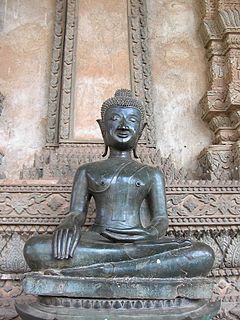
The iconography of Gautama Buddha in Laos and Thailand recall specific episodes during his travels and teachings that are familiar to the Buddhists according to an iconography with specific rules. The Buddha is always represented with certain physical attributes, and in specified dress and specified poses. Each pose, and particularly the position and gestures of the Buddha's hands, has a defined meaning which is familiar to Buddhists. In other Buddhist countries, different but related iconography is used, for example the mudras in Indian art. Certain ones of these are considered particularly auspicious for those born on particular days of the week.
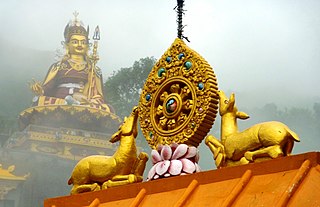
The dharmachakra or wheel of dharma is a widespread symbol used in South Asian religions such as Hinduism, Jainism, and especially Buddhism.

Sculpture in the Indian subcontinent, partly because of the climate of the Indian subcontinent makes the long-term survival of organic materials difficult, essentially consists of sculpture of stone, metal or terracotta. It is clear there was a great deal of painting, and sculpture in wood and ivory, during these periods, but there are only a few survivals. The main Indian religions had all, after hesitant starts, developed the use of religious sculpture by around the start of the Common Era, and the use of stone was becoming increasingly widespread.

Assaji was one of the first five arahants of Gautama Buddha. He is known for his conversion of Sariputta and Mahamoggallana, the Buddha's two chief male disciples, counterparts to the nuns Khema and Uppalavanna, the chief female disciples. He lived in what is now Uttar Pradesh and Bihar in northern India, during the 6th century BCE.

Sarnath Museum is the oldest site museum of Archaeological Survey of India. It houses the findings and excavations at the archaeological site of Sarnath, by the Archaeological Survey of India. Sarnath is located near Varanasi, in the state of Uttar Pradesh. The museum has 6,832 sculptures and artefacts.

The International Peace Gardens is a botanical garden located in Jordan Park in Salt Lake City, Utah.

The Sultanganj Buddha is a Gupta–Pala transitional period sculpture, the largest substantially complete copper Buddha figure known from the time. The statue is dated to between 500 and 700 AD. It is 2.3 m high and 1 m wide and weighs over 500 kg. It was found in the East Indian town of Sultanganj, Bhagalpur district, Bihar in 1861 during the construction of the East Indian Railway. It is now in the Birmingham Museum and Art Gallery, Birmingham, England.

The Seated Buddha from Gandhara is an early surviving statue of the Buddha discovered at the site of Jamal Garhi in ancient Gandhara in modern-day Pakistan, that dates to the 2nd or 3rd century AD during the Kushan Empire. Statues of the "enlightened one" were not made until the 1st century CE. Before that, Buddha were generally represented by aniconic symbols. Like other Gandharan, Greco-Buddhist art, and Kushan art, the statue shows influence from Ancient Greek art depicting Buddhist themes. The artwork is now in room 22 of the British Museum.
Buddhavanam is a tourism project in Nagarjuna Sagar, Telangana created by the Telangana State Tourism Development Corporation. The project was sanctioned by the Government of India viz., Integrated Development of Nagarjunasagar as part of Lower Krishna valley Buddhist circuit with a view to attract large number of domestic and foreign tourists particularly from the South-East Asian countries.
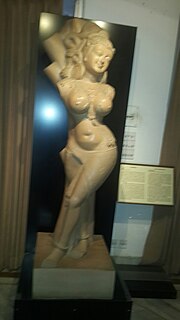
The Children's Museum, Siri Fort, established by the Archaeological Survey of India (ASI) is a museum specifically created to educate children on the cultural, archaeological and historical heritage of India through replicated sculptures created from the existing well known sculptures in various museums and heritage sites in the country. The museum houses 30 such sculptures created by students of the College of Arts and Crafts, Patna, under the direction of K. K. Mohammed, an archaeologist who had formerly worked as Superintendent Archaeologist of ASI's Delhi circle. The museum is located in a lane adjoining the Siri Fort Auditorium and Siri Fort sports complex in South Delhi, New Delhi. A unique life-size sculpture created and exhibited in the museum is of Mughal Emperor Akbar which is not found anywhere else in the country. There are also statues of Emperor Ashoka, and Shah Jahan; these three statues were added when the museum was opened for public viewing in May 2011 and are located in the garden surrounding the museum.
Badulla Bronze Buddha is a Buddha statue belonging to Sri Lanka’s Anuradhapura period. The sculpture, found in the Badulla, Sri Lanka was created around 6th century AD. This statue is made of hollow cast bronze. Currently displayed at Colombo National Museum, this statue is 54.5 cm high.
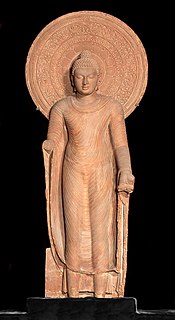
Gupta art is the art of the Gupta Empire, which ruled most of northern India, with its peak between about 300 and 480 CE, surviving in much reduced form until c. 550. The Gupta period is generally regarded as a classic peak and golden age of North Indian art for all the major religious groups. Gupta art is characterized by its "Classical decorum", in contrast to the subsequent Indian medieval art, which "subordinated the figure to the larger religious purpose".

The Buddha Preaching his First Sermon(Sarnath) is a stone sculpture of the 5th-century CE showing Gautama Buddha in the "teaching posture". The relief is 5' 3" tall, and was excavated at Sarnath, India by F. O. Oertel during the 1904–1905 excavation season of the Archaeological Survey of India (ASI); it was found in an area to the south of the Dhamek Stupa. A product of the local Sarnath school of sculpture, it has been displayed at the Archaeological Museum at Sarnath, the first site museum of the ASI, from the time of the museum's completion in 1910. It is the best known of the Buddha images addressing this theme in the museum.

Preaching Buddha is a sculpture in Salt Lake City's International Peace Gardens, in the U.S. state of Utah.
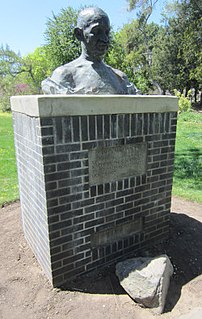
A bust of Mahatma Gandhi is installed in Salt Lake City, Utah, United States. Donated by the Government of India and the Consul General of India in 1997, the sculpture is displayed in India's section of Jordan Park's International Peace Gardens. The work was dedicated on May 10, 1997.
















